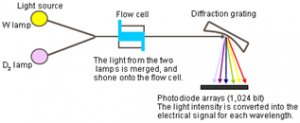Diode Array Detector HPLC
A Diode Array Detector (DAD), also known as Photodiode Array (PDA), is a widely employed chromatographic tool, especially in high-performance liquid chromatography (HPLC). Its primary function is to simultaneously detect and quantify various sample compounds with varying wavelengths of light absorbance, within the ultraviolet and visible (UV-VIS) range. This detailed explanation of the detector’s principle is accompanied by an illustrative figure (Figure 1) for enhanced comprehension.

Figure 1. Scheme of the DAD
To initiate the process, the detector utilizes two light sources emitting a broad spectrum, typically within the UV-VIS range (190 to 900 nm), directed through the sample. Under high pressure, the sample, liquid containing separated analytes, moves through a flow cell positioned in the detector’s optical path. This transparent container facilitates the interaction of the sample with the incident light.
The term “Diode Array” denotes an array of diodes, each sensitive to a specific wavelength of light. This array comprehensively covers a broad range of wavelengths. As the light penetrates the sample in the flow cell, various analytes absorb light at distinct wavelengths based on their chemical properties.
For each target compound in the sample, the diode array detector measures light intensity at different wavelengths, capturing a spectrum for each data point in the chromatogram. This accumulation results in a complete absorption profile. Subsequent data analysis enables the identification and quantification of diverse components in the sample. The absorption spectrum proves advantageous for a more thorough analysis when compared to single-wavelength detectors.
Diode Array Detectors offer notable advantages by providing detailed information about sample composition, particularly beneficial in handling complex mixtures. Additionally, they facilitate peak purity analysis and can verify analyte identities based on their spectral characteristics via the acquisition of data in the third dimension. It is important to note that for effective use of this detector, analytes must possess the capability to absorb the emitted light of the Deuterium (D2) and Tungsten (W) lamps; otherwise, they will pass through undetected.
In summary, the operation of a Diode Array Detector involves utilizing two lamps in the UV-VIS range along with an array of diodes to measure light absorption by sample compounds, at multiple wavelengths, resulting in a comprehensive spectrum.
Consumables and Spares available from SCION:
- SCION 6430 Diode Array Detector (LC20200011)
- Peek tubing (LC21000001)
- D2 Lamp (LC20210125)
- W Lamp (LC20210094)
- Flow cell unit (LC20200036)
- HG Lamp (LC20210108)
Order Today
For more information or to place an order, please get in touch.
